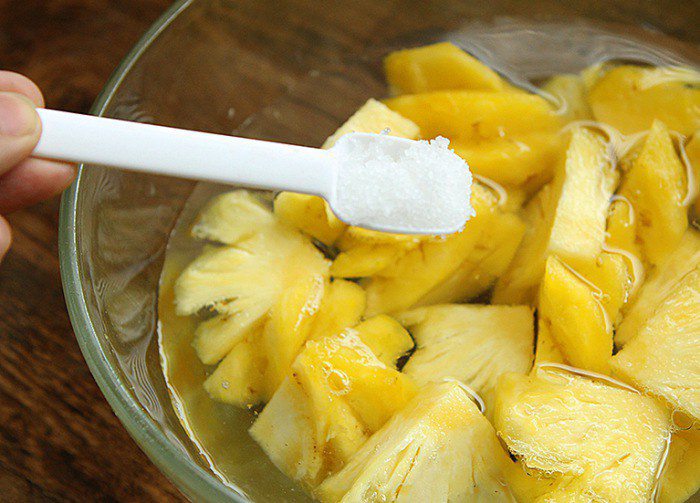Pineapple is a popular fruit loved by many for its sweet and tangy flavor. It is often consumed fresh, juiced, baked into treats, or dried, and each preparation is delicious. This tropical fruit is packed with nutrients, including vitamins A and C, calcium, potassium, and phosphorus, while being low in fat and cholesterol, making it a nutritious snack.
Adding pineapple to your diet can be a great way to boost and maintain your health. However, consuming large quantities of pineapple can leave an unpleasant tingling sensation in the mouth, which may deter some people from enjoying this fruit.

So, how can we mitigate this tingling sensation? A simple trick recommended by chefs is to soak the pineapple in a specific solution after peeling. Here’s how you can do it:
Firstly, select a naturally ripened pineapple with a deep yellow color. The yellower the pineapple, the sweeter and more mature it is compared to those with a greenish tint. Additionally, opt for larger fruits. When a pineapple is fully ripe and sizeable, its flesh is more developed, yielding more juicy and naturally sweet fruit. Avoid overly hard or rotten pineapples.
Peel the pineapple with a sharp knife, removing the eyes. Then, cut the fruit into evenly sized pieces. It is best not to soak a whole pineapple; instead, cut it into smaller pieces to reduce the tingling sensation.
**Method 1: Soak Pineapple in Saltwater**
Mix a small amount of warm water with a pinch of salt in a bowl, then add the pineapple pieces and soak them for about 30 minutes. Afterward, remove the pieces, pat them dry with a kitchen towel, and serve them on a plate.
The reason for soaking pineapple in saltwater is that it contains proteases, which can cause a tingling sensation in the mouth. Soaking in saltwater helps break down these proteases, making the fruit taste sweeter and reducing the tingling effect.
Additionally, like many other fruits that are peeled, pineapple can quickly lose its freshness and change color. Soaking it in saltwater helps preserve its freshness for a longer period.
**Method 2: Soak Pineapple in Baking Soda Solution**
Prepare a bowl of warm water and add a small amount of baking soda. Stir the solution with a chopstick until the baking soda is fully dissolved, then soak the pineapple pieces for about 10 minutes before serving.

This method is slightly more effective than saltwater as it helps retain the pineapple’s natural color and flavor while reducing the tingling sensation.
*According to Dan Viet*









